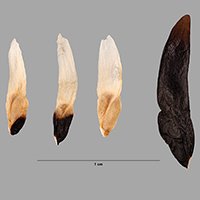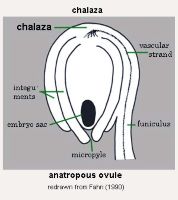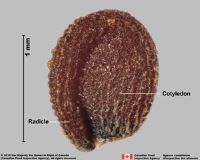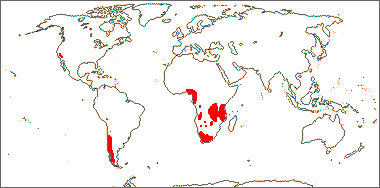Family name: Tecophilaeaceae Leyb.
Synonym(s): Androsynaceae Salisb.; Cyanastraceae Engl., nom. cons.; Cyanellaceae Salisb.; Walleriaceae H. Huber ex Takht., nom. cons.
Common name(s): cyanella family
*Number of genera/species: 9/27
List of genera records in GRIN-Global
seed
Fruit a loculicidalloculicidal:
type of capsular dehiscence, opening longitudinally through the locules (compare septicidal)
 capsulecapsule:
capsulecapsule:
a dry, dehiscent fruit derived from a compound ovary , usually trilobed, 8–20 mm long, globoseglobose:
, usually trilobed, 8–20 mm long, globoseglobose:
3D shape—more or less spherical , ovoidovoid:
, ovoidovoid:
3D shape—ovate , or ellipsoidellipsoid:
, or ellipsoidellipsoid:
3D shape—elliptic
, sometimes perianth persistent, with few to many seeds. Pericarppericarp:
fruit wall or fruit coat
green, yellow, or orange, membranousmembranous:
texture—extremely thin, pliable, and fairly tough
, often with visible veins, wrinkledwrinkled:
surface relief—shallow, irregular folds and furrows covering the surface; appearing overall though crumpled and then spread out .
.
Seeds globoseglobose:
3D shape—more or less spherical , ellipsoidellipsoid:
, ellipsoidellipsoid:
3D shape—elliptic
, or ovoidovoid:
3D shape—ovate , tereteterete:
, tereteterete:
approximately circular in cross section; width and thickness approximately equal
 or flattened in transection, less than 5 mm long, but larger seeds 5–9 mm long (Cyanastrum, Kabuyea, Walleria). Smaller seeds ellipsoidellipsoid:
or flattened in transection, less than 5 mm long, but larger seeds 5–9 mm long (Cyanastrum, Kabuyea, Walleria). Smaller seeds ellipsoidellipsoid:
3D shape—elliptic
or ovoidovoid:
3D shape—ovate (Odontospermum), flattened in transection, seed coats black to brown, shinyshiny:
(Odontospermum), flattened in transection, seed coats black to brown, shinyshiny:
uniformly reflecting a high proportion of incident light at all angles , phytomelanphytomelan:
, phytomelanphytomelan:
carbonaceous, opaque material that usually covers the seed coat to give it a black appearance, common in certain monocot families present, thin, smooth or sculptured.
present, thin, smooth or sculptured.
For larger seeded genera, Cyanastrum seeds are yellow to brown, without phytomelanphytomelan:
carbonaceous, opaque material that usually covers the seed coat to give it a black appearance, common in certain monocot families , globoseglobose:
, globoseglobose:
3D shape—more or less spherical to pearlike, deeply pittedpitted:
to pearlike, deeply pittedpitted:
surface relief—surface with small depressions in which the areas between the hollows do not take on the appearance of a true reticular net at the chalazalchalaza:
at the chalazalchalaza:
the region at the base of the ovule where the integuments are inserted end only, and with a brown, fleshy or spongyspongy:
end only, and with a brown, fleshy or spongyspongy:
soft, light, discontinuous but cohesive, and somewhat resilient
, reticulatereticulate:
surface relief—netted, raised walls or concave grooves forming a net-like surface pattern with flat, concave, or convex interspaces cap. Kabuyea seeds are yellow, globoseglobose:
cap. Kabuyea seeds are yellow, globoseglobose:
3D shape—more or less spherical , with phytomelanphytomelan:
, with phytomelanphytomelan:
carbonaceous, opaque material that usually covers the seed coat to give it a black appearance, common in certain monocot families , and a deeply pittedpitted:
, and a deeply pittedpitted:
surface relief—surface with small depressions in which the areas between the hollows do not take on the appearance of a true reticular net seed coat with microprickles in the pits. Walleria seeds are shinyshiny:
seed coat with microprickles in the pits. Walleria seeds are shinyshiny:
uniformly reflecting a high proportion of incident light at all angles , dark-red brown, ovoidovoid:
, dark-red brown, ovoidovoid:
3D shape—ovate , lobed, without phytomelanphytomelan:
, lobed, without phytomelanphytomelan:
carbonaceous, opaque material that usually covers the seed coat to give it a black appearance, common in certain monocot families , and densely wartywarty:
, and densely wartywarty:
surface relief—distinct, rounded projections that are large relative to the fruit size; tuberculate, verrucose seed coats with tufts of hairs on the lobe apicesapex:
seed coats with tufts of hairs on the lobe apicesapex:
the point farthest from the point of attachment, or the "tip" of an organ .
.
Embryo well developed, broad, straight or slightly curvedcurved:
(of embryo) linear embryo is curved into an arch or horseshoe with the ends far apart (Walleria), and partially filling the seed coat. In Cyanastrum, embryo is large with a terminal cotyledoncotyledon:
(Walleria), and partially filling the seed coat. In Cyanastrum, embryo is large with a terminal cotyledoncotyledon:
a primary leaf of the embryo and sunken laterallateral:
and sunken laterallateral:
(of embryo) embryo lies along the side of the seed, generally towards one end; of, at, or from the side; in grasses, can refer to the sides adjacent to the dorsal and ventral sides
plumule.
Endosperm present except nearly absent in Cyanastrum.
| Fruit | |
| Type | capsulecapsule: a dry, dehiscent fruit derived from a compound ovary  |
| Size range | 8–20 mm long |
| Shape(s) | globoseglobose: 3D shape—more or less spherical  , ovoidovoid: , ovoidovoid:3D shape—ovate  , ellipsoidellipsoid: , ellipsoidellipsoid:3D shape—elliptic |
| Texture | membranousmembranous: texture—extremely thin, pliable, and fairly tough |
| Surface relief | wrinkledwrinkled: surface relief—shallow, irregular folds and furrows covering the surface; appearing overall though crumpled and then spread out  |
| Color(s) | green, yellow, orange |
| Unique features | Orange, yellow, or green capsulescapsule: a dry, dehiscent fruit derived from a compound ovary  with wrinkledwrinkled: with wrinkledwrinkled:surface relief—shallow, irregular folds and furrows covering the surface; appearing overall though crumpled and then spread out  , membranousmembranous: , membranousmembranous:texture—extremely thin, pliable, and fairly tough fruit walls. |
| Seed | |
| Size range | usually less than 5 mm long, except in a few genera |
| Shape(s) | globoseglobose: 3D shape—more or less spherical  , ellipsoidellipsoid: , ellipsoidellipsoid:3D shape—elliptic , ovoidovoid: 3D shape—ovate  |
| Surface relief | reticulatereticulate: surface relief—netted, raised walls or concave grooves forming a net-like surface pattern with flat, concave, or convex interspaces  , spinyspiny: , spinyspiny:having slender, stiff, sharp projections oriented in the general plane of the structure  , pittedpitted: , pittedpitted:surface relief—surface with small depressions in which the areas between the hollows do not take on the appearance of a true reticular net  , clathrateclathrate: , clathrateclathrate:latticelike in appearance , wartywarty: surface relief—distinct, rounded projections that are large relative to the fruit size; tuberculate, verrucose  |
| Color(s) | black, yellow, brown |
| Other | |
| Embryo | well developed, broad, straight or slightly curvedcurved: (of embryo) linear embryo is curved into an arch or horseshoe with the ends far apart  (Walleria), and partially filling the seed coat. In Cyanastrum, embryo is large with a terminal cotyledoncotyledon: (Walleria), and partially filling the seed coat. In Cyanastrum, embryo is large with a terminal cotyledoncotyledon:a primary leaf of the embryo  and sunken laterallateral: and sunken laterallateral:(of embryo) embryo lies along the side of the seed, generally towards one end; of, at, or from the side; in grasses, can refer to the sides adjacent to the dorsal and ventral sides plumule. |
| Nutritive tissue | endosperm present except nearly absent in Cyanastrum |
Africa, Chile, U.S.A.

Distribution map courtesy of Angiosperm Phylogeny Website.
Baskin and Baskin 2021Baskin and Baskin 2021:
Baskin C and Baskin J. 2021. Relationship of the lateral embryo (in grasses) to other monocot embryos: A status up-grade. Seed Science Research 31 (3): 199-210. doi:10.1017/S0960258521000209; Bingham et al. 2021+Bingham et al. 2021+:
Bingham MG, Willeman A, Wursten BT, Ballings P, and Hyde MA. 2021. Flora of Zambia. Accessed January 2021–April 2024. URL: https://www.zambiaflora.com; Carter 1966bCarter 1966b:
Carter S. 1966b. Tecophilaeaceae. In: Milne-Redhead E and Polhill RM, eds. Flora of Tropical East Africa. Vol 179. Crown Agents for Oversea Governments and Administrations, London UK. 7 pp.; Dahlgren et al. 1985Dahlgren et al. 1985:
Dahlgren RMT, Clifford HT, and Yeo PF. 1985. The families of the monocotyledons: structure, evolution, and taxonomy. Springer-Verlag, Berlin. 520 pp.; Flora of North America Editorial Committee 1993+Flora of North America Editorial Committee 1993+:
Flora of North America Editorial Committee, eds. 1993+. Flora of North America North of Mexico [Online]. 22+ vols. Flora of North America Association, New York and Oxford. Accessed January-March 2024. URL: http://beta.floranorthamerica.org.; Kirkbride et al. 2006Kirkbride et al. 2006:
Kirkbride JH, Jr, Gunn CR, and Dallwitz MJ. 2006. Family guide for fruits and seeds, vers. 1.0. Accessed September 2020-January 2022. URL: https://nt.ars-grin.gov/seedsfruits/keys/frsdfam/index.cfm .; Kubitzki et al. 1990+Kubitzki et al. 1990+:
Kubitzki K et al., eds. 1990+. The families and genera of vascular plants. 7+ vols. Berlin etc.; Stevenson and Loconte 1995Stevenson and Loconte 1995:
Stevenson DW and Loconte H. 1995. A cladistic analysis of monocot families. In: Rudall PJ, Cribb PJ, Cutler DF, and Humphries CJ, eds. Monocotyledons: Systematics and Evolution. Royal Botanic Gardens, Kew.
*The number of genera and species is based on Christenhusz and Byng 2016Christenhusz and Byng 2016:
Christenhusz MJM and Byng JW. 2016. The number of known plant species in the world and its annual increase. Phytotaxa 261 (3): 201-217. https://doi.org/10.11646/phytotaxa.261.3.1, which may differ from the number of genera in GRIN-Global.